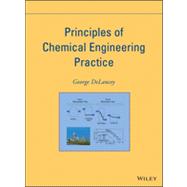
Note: Supplemental materials are not guaranteed with Rental or Used book purchases.
Purchase Benefits
What is included with this book?
GEORGE DeLANCEY, PhD, is Professor Emeritus in the Department of Chemical Engineering and Materials Science at Stevens Institute of Technology. He has more than forty years experience in chemical engineering education, having taught process analysis and process control in the undergraduate school. He has twice been the recipient of the Outstanding Teacher Award at Stevens. He has served as Senior Academic Advisor to the International Programs Office at Stevens with curriculum development responsibilities in gas and plastics engineering and technology programs at the Algerian Petroleum Institute. Dr. DeLancey has more than thirty publications in the areas of multicomponent mass and energy transfer with chemical reaction, interfacial mass and energy transfer in gas–liquid systems, and chemical engineering education and assessment.
Preface P-1
Part I. Macroscopic View 1-1
1. Chemical Process
Perspective 1-11.1. Some basic concepts in chemical processing 1-2
1.2. Acrylic acid production 1-6
1.3. Biocatalytic Processes - Enzymatic systems 1-38
1.4 Basic database 1-44
Problems 1-47
2. Macroscopic Mass Balances 2-1
2.1 Chemical Processing Systems 2-2
2.2 Steady state mass balances without chemical reactions 2-29
2.2.1 Degrees of freedom 2-30
2.3.1 Degrees of freedom: reaction rate and key component 2-42
2.4 Steady state mass balances with multiple chemical reactions 2-53
Problems 2-68
3. Macroscopic Energy and Entropy Balances 3-1
3.1 Basic thermodynamic functions 3-2
3.2 Evaluation of H and S for pure materials 3-9
3.3 Evaluation of H and S Functions for Mixtures 3-22
3.4 Energy flows and the First Law 3-32
3.5 Energy Balances without Reaction 3-37
3.6 Energy Balances with reaction- ideal solution 3-54
3.7 Entropy balances 3-78
3.7.4.2 Distillation 3-92
Problems 3-97
4. Macroscopic Momentum and Mechanical Energy Balances 4-1
4.1 Momentum balance 4-1
4.2 Mechanical energy balance 4-7
4.3 Applications to incompressible flow systems 4-9
Problems 4-28
5. Completely Mixed Systems Equipment Considerations 5-1
5.1 Mixing and residence time distributions-definitions 5-2
5.2 Measurement and interpretation of residence time distributions 5-6
5.3 Basic aspects of stirred tank design 5-13
Problems 5-31
6. Separation and reaction processes in completely mixed systems 6-1
6.1 Phase equilibrium: single stage separation operations 6-1
6.2 Gas liquid operations 6-7
6.3 Flash vaporization 6-67
6.4 Liquid-liquid extraction 6-99
6.5 Adsorption 6-121
6.6. Single phase stirred tank reactors 6-141
6.7 Chemical reaction equilibrium 6-184
Problems 6-199
Part II. Microscopic View 7-1
7. Multistage Separation and Reactor Operations 7-1
7.1 Absorption and stripping 7-3
7.2 Distillation 7-28
7.3 Liquid Liquid Extraction 7-81
7.4 Multiple reactor stages 7-104
7.5 Staged fixed bed converters for exothermic gas phase reaction 7-115
Problems 7-121
8. Microscopic Equations of Change 8-1
8.1 Mass Flux: Average velocities and diffusion 8-3
8.2 Momentum flux: Stress tensor 8-18
8.3 Energy flux: Conduction 8-23
8.4 Balance equations 8-26
8.5 Entropy Balance and Flux Expressions 8-37
8.6 Turbulence 8-83
8.7 Application of Balance Equations 8-92
Problems 8-115
9. Nonturbulent Isothermal Momentum Transfer 9-1
9.1 Rectangular models 9-4
9.2 Cylindrical systems 9-10
9.4 Spherical systems 9-33
9.5 Microfluidics - gas phase systems 9-42
Problems 9-56
10. Nonturbulent Isothermal Mass Transfer 10-1
10.1 Membranes 10-3
10.2 Diffusion models for porous solids 10-31
10.3 Heterogeneous catalysis 10-42
10.4 Transient adsorption by porous solid 10-55
10.5 Diffusion with Laminar flow 10-63
Problems 10-76
11. Energy Transfer under Non-turbulent Conditions 11-1
11.1 Conduction in solids - composite walls 11-3
11.2 Thermal effects in porous catalysts 11-10
11.3 Heat transfer to falling film-short contact times 11-19
11.4 Moving boundary problem 11-24
Problems 11-30
12. Isothermal Mass Transfer under Turbulent Conditions 12-1
12.1 Intraphase mass transfer coefficients 12-1
12.2 Interphase mass transfer coefficients- Controlling resistances 12-10
12.3 Measurement and correlation of mass transfer coefficients 12-13
12.4 Fixed bed 12-21
12.5 Pipes 12-28
12.6 Particles, drops, and bubbles in agitated systems 12-33
12.7 Packed towers- gas absorption 12-40
12.8 Applification of experimental mass transfer coefficients 12-66
Proble
ms 12-92
13. Interphase Momentum Transfer under Turbulent Conditions 13-1
13.1 Pressure drop in conduits and fixed beds 13-3
13.2 Flow over submerged spheres 13-30
Problems 13-46
14. Interphase Energy Transfer under Turbulent Conditions 14-1
14.1 Heat transfer coefficients analogy with mass transfer 14-1
14.2 Heat exchangers 14-4
14.3 Multi-tubular catalytic reactors 14-33
Problems 14-44
15. Microscopic to Macroscopic 15-1
15.1 Macroscopic mass balance 15-3
15.2 Macroscopic energy balance 15-6
15.3 Macroscopic mechanical energy balance 15-10
Problems 15-16
Appendix A: Periodic table A-1
Appendix B: Conversion factors B-1
Appendix C: Partial database for acrylic acid process C-1
Appendix D: Some mathematical results D-1
Appendix E: Mass balance in cylindrical coordinates and laminar flow in z direction E-1
Nomenclature N-1
Thermodynamic T-1
References R-1
Index I-1
The New copy of this book will include any supplemental materials advertised. Please check the title of the book to determine if it should include any access cards, study guides, lab manuals, CDs, etc.
The Used, Rental and eBook copies of this book are not guaranteed to include any supplemental materials. Typically, only the book itself is included. This is true even if the title states it includes any access cards, study guides, lab manuals, CDs, etc.